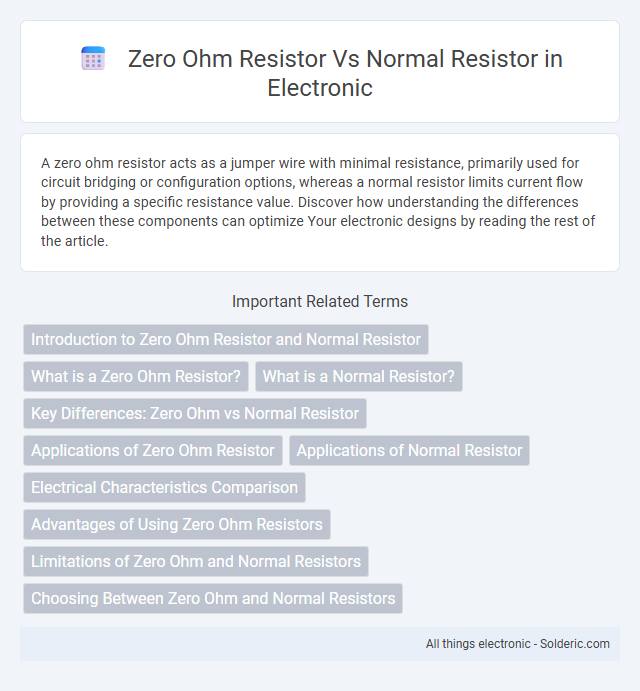A zero ohm resistor acts as a jumper wire with minimal resistance, primarily used for circuit bridging or configuration options, whereas a normal resistor limits current flow by providing a specific resistance value. Discover how understanding the differences between these components can optimize Your electronic designs by reading the rest of the article.
Comparison Table
| Feature | Zero Ohm Resistor | Normal Resistor |
|---|---|---|
| Resistance Value | Approximately 0 O | Typically from 1 O to several MO |
| Purpose | PCB jumper or bridge | Control current and voltage in circuits |
| Power Rating | Usually low (e.g., 1/8 W to 1/4 W) | Varies widely (1/8 W to several watts) |
| Usage | Short circuit connection, configuration options | Current limiting, voltage division, biasing |
| Packaging | SMD or through-hole, same as normal resistors | SMD or through-hole |
| Cost | Low, similar to normal resistors | Varies by resistance and power rating |
| Measurement | Near zero ohms on ohmmeter | Value matches resistance rating |
Introduction to Zero Ohm Resistor and Normal Resistor
A zero ohm resistor is essentially a wire link used to bridge traces on a PCB, offering minimal resistance to maintain circuit continuity, unlike a normal resistor which provides a specific resistance value to control current flow. Normal resistors are designed with precise resistance ratings measured in ohms, crucial for managing voltage and current in electronic circuits. Your choice between the two depends on whether you need a simple connection or a component that regulates electrical resistance.
What is a Zero Ohm Resistor?
A zero ohm resistor is a type of resistor designed to have very low resistance, effectively functioning as a jumper or wire on a printed circuit board (PCB). It provides a convenient way to connect traces without the need for additional wiring while maintaining a standard resistor package for automated assembly processes. Unlike normal resistors, which regulate current by providing specific resistance values, zero ohm resistors are used mainly for circuit routing and configuration purposes.
What is a Normal Resistor?
A normal resistor is an electronic component designed to limit the flow of electric current by providing a specific resistance value measured in ohms, helping control voltage and current within circuits. It dissipates electrical energy as heat and plays a crucial role in protecting sensitive components and setting signal levels in various electronic devices. Understanding how your normal resistor functions enables effective circuit design and troubleshooting.
Key Differences: Zero Ohm vs Normal Resistor
Zero ohm resistors act as jumpers allowing current to pass with minimal resistance, primarily used for circuit routing and PCB trace continuity, while normal resistors provide specific resistance values to control current flow and voltage levels. Unlike normal resistors, zero ohm resistors have negligible resistance, typically less than 0.05 ohms, making them ideal for configurable circuit designs and automated assembly. Your circuit design benefits from zero ohm resistors by simplifying layout and providing flexibility without altering electrical characteristics like standard resistors do.
Applications of Zero Ohm Resistor
Zero ohm resistors serve primarily as jumpers on printed circuit boards (PCBs), allowing designers to connect traces without altering the layout or needing additional wiring. Their presence enables flexible circuit configurations and simplifies automated PCB assembly by providing a standard resistor footprint, facilitating easy modification or testing of circuits. Your design benefits from these resistors when you require bridging or selecting different circuit paths without affecting signal integrity.
Applications of Normal Resistor
Normal resistors are essential components in electronic circuits for controlling current flow, dividing voltages, and setting bias points in amplifiers and other devices. They are widely used in applications such as limiting LED current, creating voltage drops in sensor circuits, and forming part of RC timing circuits in oscillators. Their precise resistance values enable accurate control of electrical parameters, unlike zero ohm resistors which primarily serve as simple jumper links or PCB configuration options.
Electrical Characteristics Comparison
A zero ohm resistor acts as a short circuit with negligible resistance, typically less than 0.05 ohms, allowing current to pass with minimal voltage drop, unlike a normal resistor that provides a specific resistance value to control current flow or divide voltage. Normal resistors exhibit defined resistance ranges, power ratings, tolerance, and temperature coefficients, influencing circuit behavior by dissipating energy as heat. You can use zero ohm resistors primarily for PCB trace routing or configuration, while normal resistors are essential for precise electrical parameter control in circuits.
Advantages of Using Zero Ohm Resistors
Zero ohm resistors offer the advantage of simplifying PCB layout by acting as jumpers, enabling easy circuit rerouting without redesigning the board. They facilitate automated manufacturing processes, reducing assembly errors and saving production time. Your designs benefit from enhanced flexibility and improved electrical isolation compared to traditional wiring methods.
Limitations of Zero Ohm and Normal Resistors
Zero ohm resistors function primarily as jumper wires with minimal resistance, but they lack the current-limiting and voltage drop properties of normal resistors, making them unsuitable for controlling electrical parameters. Normal resistors provide precise resistance values essential for regulating current, voltage, and signal integrity but introduce power dissipation and potential heat challenges. Your circuit design must consider that zero ohm resistors cannot replace normal resistors when specific resistance and power ratings are required.
Choosing Between Zero Ohm and Normal Resistors
Choosing between zero ohm and normal resistors depends on your circuit design needs; zero ohm resistors act as jumper wires providing a straightforward connection with minimal resistance, ideal for PCB routing flexibility. Normal resistors offer precise resistance values to control current, voltage, and signal levels within the circuit. Your selection should consider whether the component's purpose is to bridge connections or regulate electrical parameters for optimal performance.
zero ohm resistor vs normal resistor Infographic

 solderic.com
solderic.com